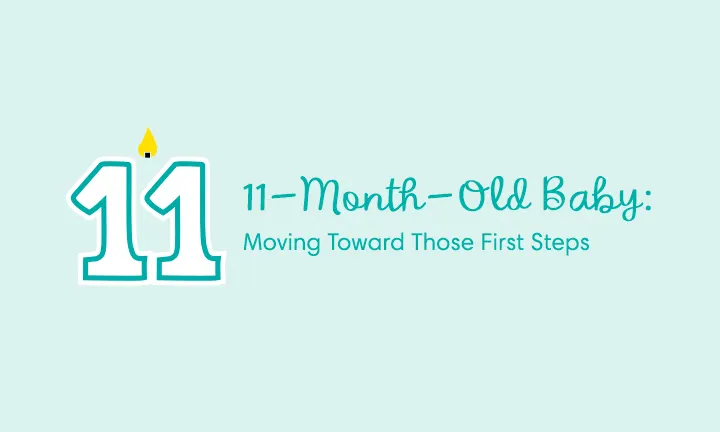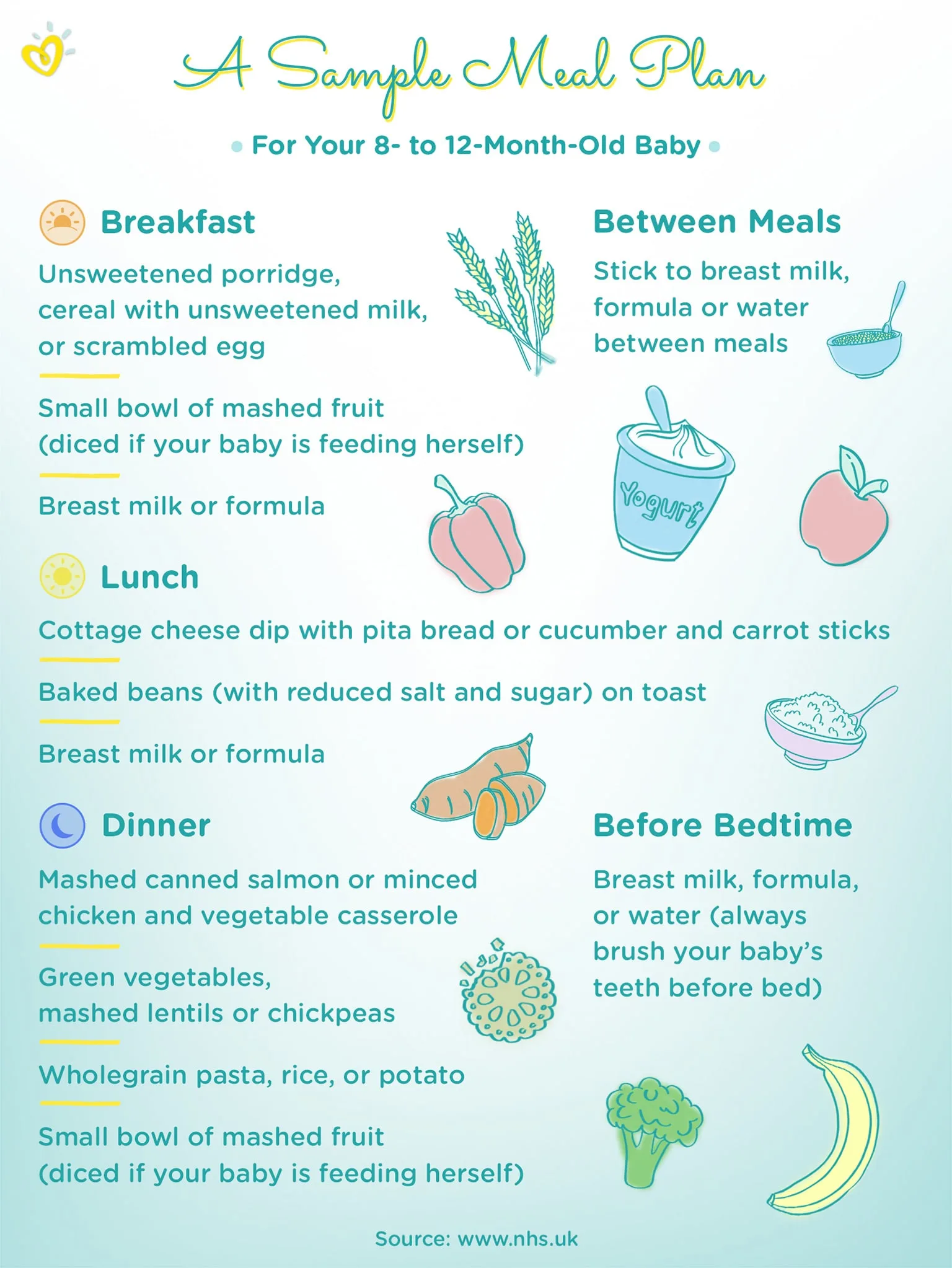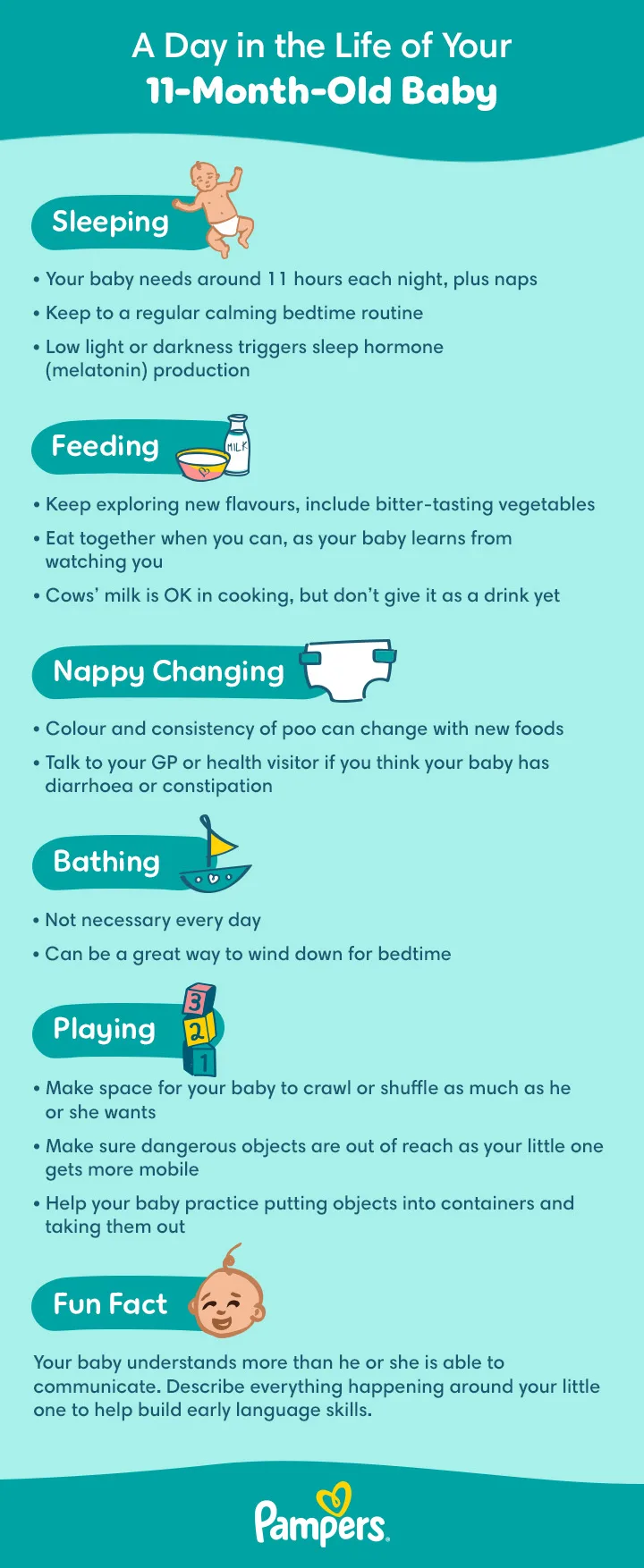11-Month-Old-Baby: Moving Toward Those First Steps
Your 11-month-old baby is becoming more active and mobile every day, and all that curiosity is helping your little one enjoy new experiences and master new skills. Read on to learn more about what your baby’s up to and how you can encourage his or her development with playtime, sleep, and feeding tips.

Baby Development Milestones
There's a lot to look forward to this month as your 11-month-old baby's curiosity leads him or her to new and exciting experiences. Your little one is exploring the world using all those brand new senses, and may even be up on his or her feet in full cruising mode. Make sure your baby’s surroundings are safe, and then watch as she makes her latest discoveries!
Physical Development: Forging Ahead
Your little one's first steps are an exciting milestone, but don't be alarmed if you notice those little feet turning outward a bit in a way that looks the opposite of pigeon toe. This is called ‘out-toeing’, and it’s common in little ones as they start learning to walk. Your baby hasn't spent much time on his or her feet yet, so the hip ligaments are still loose, causing the legs and feet to rotate outward. Just as with in-toeing, this should resolve with time.
Senses: Engaging All the Senses
Your 11-month-old uses all of his or her senses to learn and grow. Toys don't need to be expensive or complicated to capture your little one’s attention and boost brain development. Your baby may be delighted with any or all of the following:
Building blocks or stacking rings
Playing with textures, including sand, water and play dough
‘Treasure boxes’ with natural objects e.g. leaves, shells, pieces of wood or pine cones
A ‘feely bag’ filled with a variety of interesting objects of different sizes, colours, smells, shapes and textures
Blowing bubbles
Musical instruments, e.g. a shaker (a small plastic container filled with rice, dried beans or dry macaroni)
Touch and feel books
Movement: Walking Unassisted
You've seen your baby's motor skills, balance, and coordination improve over the past few months; now, your 11-month-old baby may be getting ready to take those first steps. Your little one's been building strength in the leg muscles by doing things like scooting, crawling, pulling him or herself up to stand or cruising. Now, or sometime soon, your baby may be ready to take his or her first few independent steps!
Cognitive Development: Building a Passive Vocabulary
Just as your baby’s speech abilities are improving, so are his or her listening and comprehension skills. By now, your little one can probably understand simple phrases and follow simple instructions from you, such as when you ask him or her to wave bye-bye or reach for a toy. Your baby might also be able to point out the right picture in a book when you name something.

How to Support Your Baby's Development
If your baby has already learned to pull to stand, there are a number of things you can help your little one with, including balancing. Learning to balance when standing is half the battle when it comes to walking. Encourage your baby to keep their balance when standing, by kneeling or crouching in front of your little one and talking or singing, and giving praise by clapping and smiling.
Though, at first, you might need to support your standing baby by holding his or her hands or waist, you can gradually reduce this support until your little one can stand unassisted. Once your little one is confident in standing, you can move on to playing games that require the use of both hands like pointing to different body parts at the same time You can also place some toys on the sofa or a table, to encourage your baby to play standing up.
Practice makes perfect! If your baby can already take a few steps unaided, make sure he or she is free to toddle around at will. Let him or her try walking with you instead of using a buggy.

Feeding Your 11-Month-Old Baby
By the time your baby is starting to stand up and take those first steps, he or she should already be part of family mealtimes. As your little one gets more active and uses more energy, a varied, energy-rich diet is important in order to stay healthy and grow. Babies under two have small tummies and cannot eat a lot in one go. What they need are small meals three times a day and some healthy snacks in between.
As your baby starts to move around more and more, he or she may want more food.
Make sure your little one gets full-fat dairy products including yoghurt, fromage frais and cheese. Cutting back on fat is only sensible for adults. Babies need fat for healthy development.

How Much Sleep Does a 11-Month-Old Baby Need?
With so much new activity filling his days, your baby now needs around 12 hours of sleep each night, and 2 hours and 30 minutes of naptime during the day. Even if your baby doesn’t need night feeds any more, it's possible that he or she may wake up and cry at night.
If your baby does cry at night, try waiting for a few minutes to see if he or she nods off again. If your little one doesn’t settle, check to see if he or she’s sick or uncomfortable. If your baby seems to be alright, try to soothe without giving too much stimulation by talking or picking him or her up.

A Day in the Life of Your Baby
Every baby’s routine is different, but here’s one example of what a typical day could look like for you and your baby.

Your Baby's Health: Preventing Household Accidents
One way babies explore the world around them is by putting everything in their mouths, which can lead to choking incidents. Another issue can be suffocation, for example, when playing with something that can accidentally wrap around your baby’s neck or block the nose or mouth. There are a number of things you can do to make your baby’s exploration safer:
Keep small objects like buttons, batteries and small toy parts away from your baby. Only give your baby bigger items to play with that don’t pose a choking hazard.
Cut up solid food into baby-sized pieces. Even grapes or cherry tomatoes should be cut up.
Be sure to remove the stones of any stone fruits
Don’t give your baby whole nuts, boiled sweets or other hard foods
Don’t leave your little one unattended when he or she’s eating
Don’t let him or her play with plastic bags
Don’t put pillows, blankets or duvets in your baby’s cot while he or she sleeps, as there’s a risk of suffocation of your little one’s face gets covered and he or she can’t push the duvet away.
No matter how careful you are, accidents might happen. Here’s what you can do to help your baby if he or she chokes and can’t breathe properly:
Shout for help
Try to remove the object if you can see it clearly. Poking at it blindly with your fingers will only push it in further.
If your baby is coughing loudly, encourage him or her to keep on coughing.
If there is no coughing at all or your baby can’t cough up the object, use back blows. Here’s how:
Support the chest and chin in one hand in a head downwards position, on your lap.
Don’t press the spot under her jaw, to avoid making the obstruction worse.
Deliver at least five sharp blows with the heel of your other hand between the shoulder blades to dislodge the object.
If your baby still has difficulty breathing, call 999 immediately.

FAQs at a Glance
If you’re formula feeding, you should continue to give your baby first infant formula until she’s least 1 year old. After that, no formula including first infant formula, follow-on formula or growing-up milk is required.

Your Life as a Parent: Your Social Life
Your own health and happiness are critical to being the best parent you can be. If you are on maternity leave you may feel that you would benefit from going back to work, either before your 52-week maternity leave is up or soon after.
It might help to talk to other working mums and loved ones about how best to handle the transition back to work. In the end, the choice is yours about what’s best for you and your family. These are a few issues you might want to consider when transitioning back to work:
Feeding. If your baby is still breastfeeding, you can try giving expressed breast milk from a bottle or cup. That way you can leave some milk for feeds before you go to work in the morning. Giving formula milk during the day and breastfeeding the rest of the time might also be an option. Talk to your health visitor, the National Childbirth Trust, the La Leche League GB, or the Association of Breastfeeding Mothers for more advice on this.
Arranging childcare. If your workplace doesn’t have a crèche, it’s best to choose a childcare option that gives your baby lots of opportunities to be around other children, such as a childminder (a person looking after a small number of children in their home) or a day nursery. You can also ask your family to help with childcare, or hire a nanny, who is a qualified child carer, or an au pair.
Housework. Housework can take up a lot of time, especially with a baby around. Talk to your partner about how you could share household and childcare chores. You might also find that hiring someone to help with cleaning or cooking could be a good solution. Or you might find that getting groceries delivered is an easy way of taking a time-consuming job off your plate.
Making time for your baby. You will have chosen a childcare option that meets both yours and your child's needs and hopefully your baby settles well and is happy there. Whether you have returned to full time work or had the opportunity to take advantage of flexible working arrangements, it is important to create space to have regular 1 on 1 time with your baby as you are the person they feel safest with.
Flexible working. The law gives you the right to ask your employer for flexible working arrangements. Flexible working is a working pattern different from your current one that may include changing from full-time to part-time work, home working, flexible start and finish times and working from home. You must be a regular employee and must have worked for the same employer for at least 26 weeks to be eligible.
Checklist for This Month
Plan your baby’s first birthday party. While you’re at it, check out these ways to mark your baby’s first birthday and take a look at these healthy birthday cake recipes.
Get prepared for the month ahead. Learn more about what's in store for you and your little one when he or she is 12 months old.
And, for even more info, sign up to receive our emails.
11 month old baby - checklist
How we wrote this article
The information in this article is based on the expert advice found in trusted medical and government sources, such as the National Health Service (NHS). The content on this page should not replace professional medical advice. Always consult medical professionals for full diagnosis and treatment.






